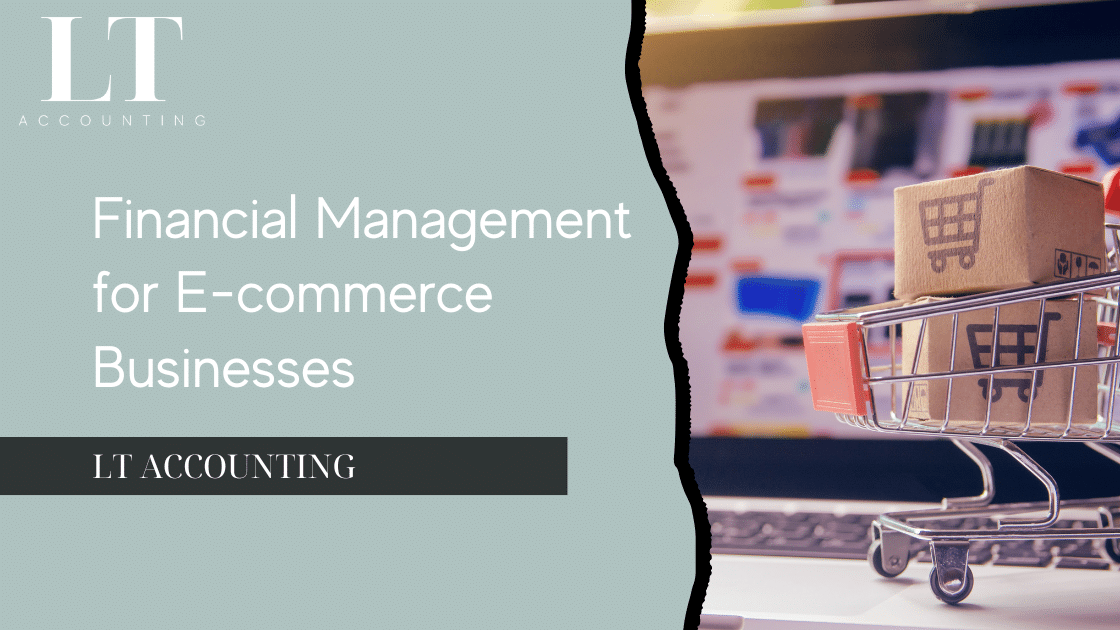Your Ultimate Guide to Bookkeeping Bliss
Hey there, fabulous e-commerce entrepreneurs! Ever felt like managing your online store’s finances is like trying to juggle flaming torches while riding a unicycle? Fear not! We’re here to help turn that financial circus into a well-oiled accounting machine. In this blog post, we’ll dive into everything you need to know about e-commerce financial management, from bookkeeping basics to expert accounting tips. Stick with us, and you’ll be a financial wizard in no time!
The Basics: Why Financial Management Matters
First things first, let’s talk about why financial management is crucial for your e-commerce business. Imagine driving a car without a dashboard – you wouldn’t know how fast you’re going, if you’re low on fuel, or if the engine’s about to overheat. The same goes for your online store. Proper financial management gives you the insights you need to make informed decisions, keep your business healthy, and plan for the future.
Keeping the Cash Flowing
Cash flow management is the lifeblood of any business, especially in e-commerce where transactions happen at lightning speed. You need to know exactly how much money is coming in and going out. This helps you avoid nasty surprises like overdraft fees or cash shortages.
Staying Compliant with Taxes
Taxes – the necessary evil. Keeping your books in order ensures you’re paying the right amount of tax and not a penny more. Plus, come tax season, you won’t be tearing your hair out trying to find receipts in the bottom of your sock drawer.
Scaling Your Business
With your finances in check, you can accurately gauge your business’s performance and identify opportunities for growth. Want to launch a new product line or expand to a new market? Good financial management will show you if it’s feasible.
Bookkeeping Basics for Online Stores
Now that we’ve covered the why, let’s dive into the how. Bookkeeping is the backbone of financial management. It might sound about as exciting as watching paint dry, but stick with us – we promise it’s worth it.
Choosing Your Method
There are two main bookkeeping methods: cash basis and accrual basis. Cash basis records transactions when money actually changes hands. Accrual basis records transactions when they’re earned or incurred, regardless of when the money moves. Most small e-commerce businesses start with cash basis, but as you grow, you might switch to accrual for a more accurate picture.
Setting Up Your Chart of Accounts
Your chart of accounts is like a roadmap for your finances. It categorizes every transaction, making it easier to track income, expenses, assets, and liabilities. Set it up right from the start, and you’ll thank yourself later.
Using Accounting Software
Gone are the days of ledgers and quill pens. Modern accounting software like QuickBooks, Xero, or Wave can automate much of your bookkeeping, saving you time and reducing errors. Plus, they often integrate with your e-commerce platform.
Inventory Management: Keep Your Stock in Check
Inventory management is more than just counting widgets. It’s about ensuring you have the right products in the right quantities at the right time, without tying up too much cash in stock.
Tracking Inventory Levels
Use inventory management software to track stock levels in real-time. This helps you avoid stockouts and overstocking, both of which can hurt your bottom line.
Implementing Just-In-Time Inventory
Just-In-Time (JIT) inventory means you order stock only when you need it, reducing storage costs and freeing up cash. However, it requires a reliable supply chain, so make sure your suppliers are up to the task.
Regular Audits and Reconciliations
Conduct regular inventory audits to ensure your physical stock matches your records. Discrepancies can indicate theft, damage, or accounting errors, all of which need to be addressed pronto.
Sales Tracking: Know What’s Selling
Sales tracking is more than just counting up your cash register receipts. It’s about understanding which products are flying off the shelves and which are gathering dust.
Analyzing Sales Data
Use your e-commerce platform’s analytics tools to track sales by product, category, and time period. Look for trends and patterns to inform your marketing and inventory decisions.
Identifying Bestsellers
Identify your bestsellers and focus your marketing efforts on them. Consider bundling them with slower-moving items to boost overall sales.
Monitoring Sales Channels
If you sell on multiple platforms (your website, Amazon, eBay, etc.), track sales on each channel separately. This helps you understand which platforms are most profitable and where to focus your efforts.
Expense Management: Keep Costs Under Control
Running an e-commerce business involves a lot of expenses – from website hosting and marketing to shipping and packaging. Keeping these costs under control is vital for maintaining profitability.
Categorising Expenses
Categorise your expenses in your accounting software to see where your money is going. Common categories include marketing, shipping, software, and office supplies.
Cutting Unnecessary Costs
Regularly review your expenses and look for areas where you can cut costs without sacrificing quality. For example, can you negotiate better rates with suppliers or switch to a more affordable software plan?
Investing Wisely
Some expenses are necessary investments in your business’s growth. For example, spending on marketing can drive sales, and investing in better software can save you time and reduce errors. Make sure you’re spending wisely and getting a good return on investment.
Tax Considerations: Stay on the Right Side of HMRC
Taxes are a fact of life, but they don’t have to be a headache. With proper planning and recordkeeping, you can stay compliant and avoid costly penalties.
Understanding VAT
If your e-commerce business is VAT-registered, you need to charge VAT on sales and reclaim it on eligible expenses. Make sure you understand the rules and keep detailed records.
Keeping Detailed Records
Good recordkeeping is essential for tax compliance. Keep copies of all invoices, receipts, and bank statements, and use accounting software to track everything.
Hiring a Professional
If taxes make your head spin, consider hiring a professional accountant. They can help you stay compliant, maximize deductions, and save you time and stress.
Financial Reporting: Know Your Numbers
Regular financial reporting gives you a snapshot of your business’s performance and helps you make informed decisions.
Profit and Loss Statement
Your profit and loss statement (P&L) shows your revenue, expenses, and profit over a specific period. Review it regularly to see how your business is performing.
Balance Sheet
Your balance sheet provides a snapshot of your business’s financial position at a specific point in time. It shows your assets, liabilities, and equity.
Cash Flow Statement
Your cash flow statement shows how money is flowing in and out of your business. It’s crucial for managing cash flow and ensuring you have enough cash to cover expenses.
Budgeting: Plan for Success
Budgeting helps you plan for the future and ensures you have the resources you need to achieve your goals.
Setting Realistic Goals
Set realistic financial goals based on your past performance and market conditions. For example, you might aim to increase sales by 10% or reduce expenses by 5%.
Creating a Budget
Create a detailed budget that outlines your expected revenue and expenses. Use your accounting software to track your actual performance against your budget.
Adjusting as Needed
Review your budget regularly and adjust as needed. If you’re not meeting your goals, look for areas where you can improve. If you’re exceeding your goals, consider investing in growth opportunities.
Technology: Leverage the Power of Automation
Modern technology can save you time, reduce errors, and streamline your financial management processes.
E-commerce Platforms
Choose an e-commerce platform that integrates with your accounting software. This ensures your sales data is automatically synced, reducing manual data entry.
Accounting Software
Use accounting software to automate your bookkeeping and financial reporting. Look for features like bank feeds, invoicing, and expense tracking.
Inventory Management Software
Inventory management software can help you track stock levels, manage orders, and optimize your inventory. Look for features like real-time tracking and automated reordering.
Continuous Learning: Stay Ahead of the Curve
The world of e-commerce is constantly evolving, and staying ahead of the curve is crucial for success.
Keeping Up with Trends
Stay informed about industry trends and best practices. Follow industry blogs, attend webinars, and join online forums to stay in the loop.
Investing in Education
Invest in your education by taking courses and attending workshops. Many online platforms offer courses on e-commerce, accounting, and financial management.
Networking with Peers
Network with other e-commerce entrepreneurs to share knowledge and learn from each other’s experiences. Join local business groups, attend industry events, and participate in online communities.
And there you have it! With these tips and tricks, you’ll be well on your way to mastering e-commerce financial management and bookkeeping. Remember, managing your finances doesn’t have to be a chore – it can be a rewarding part of growing your business. So grab a cup of tea, fire up your accounting software, and get ready to take your e-commerce business to new heights!
Slug: financial-management-ecommerce-businesses
Meta Description: Master e-commerce financial management with our ultimate guide. Discover bookkeeping basics, inventory management, sales tracking, tax considerations, and more, all in a friendly and humorous tone.




